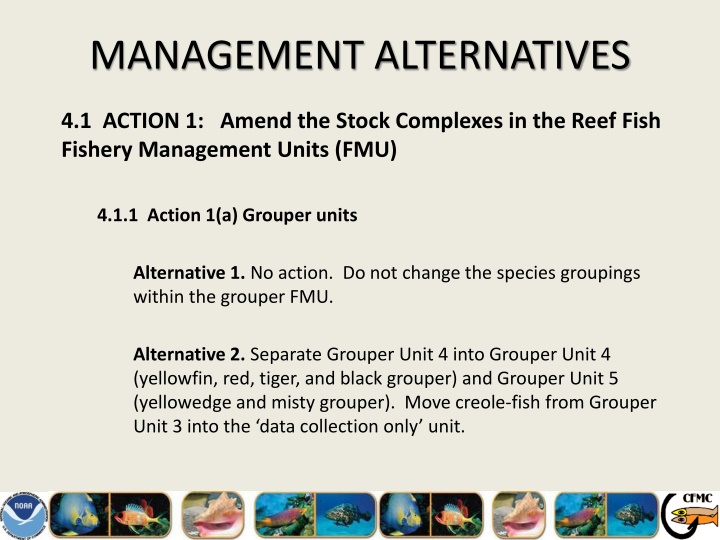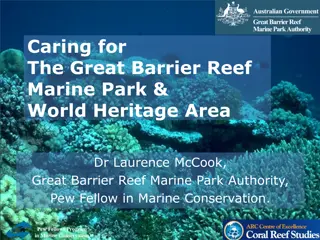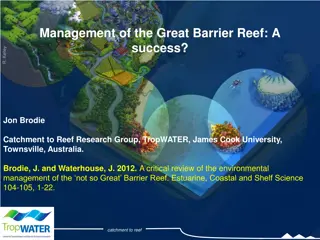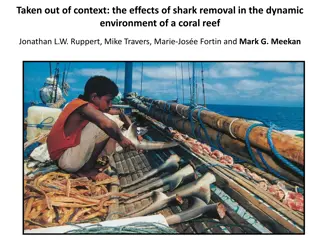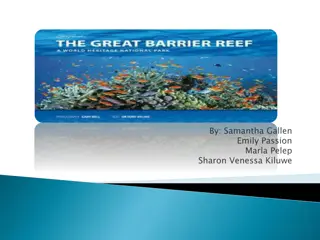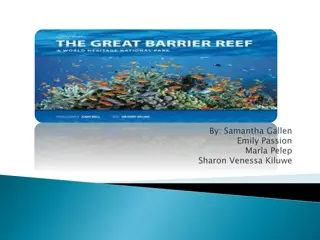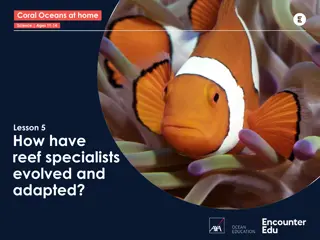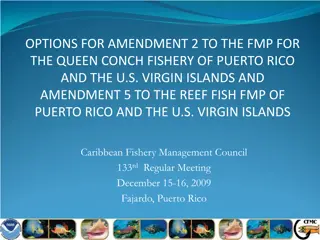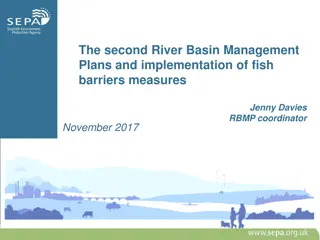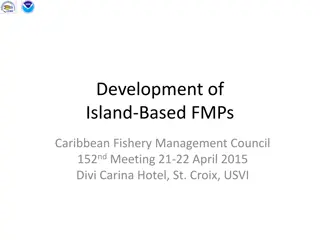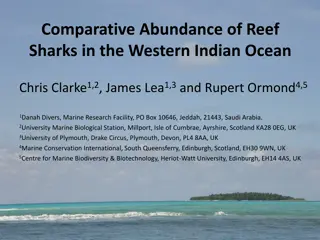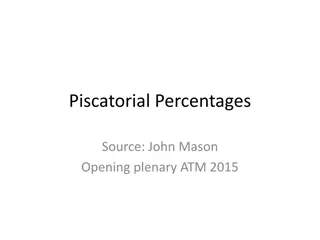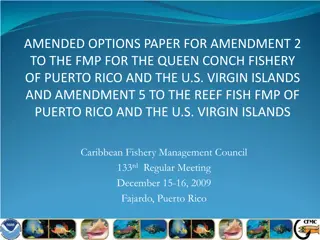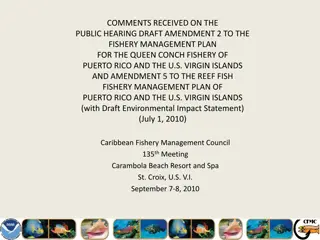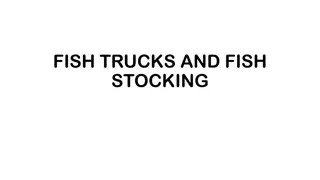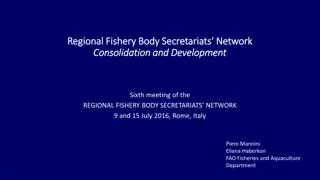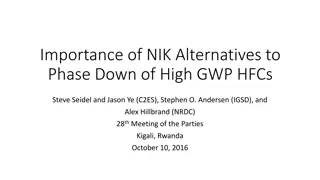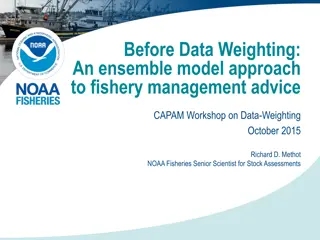Reef Fish Fishery Management Alternatives Overview
Amend the stock complexes in the reef fish fishery management units by considering different actions for the grouper and snapper units. The proposed alternatives aim to redefine management reference points for various species groups within the snapper, grouper, and parrotfish complexes. These adjustments are crucial for the sustainable management of marine resources and to address overfishing concerns.
Download Presentation

Please find below an Image/Link to download the presentation.
The content on the website is provided AS IS for your information and personal use only. It may not be sold, licensed, or shared on other websites without obtaining consent from the author.If you encounter any issues during the download, it is possible that the publisher has removed the file from their server.
You are allowed to download the files provided on this website for personal or commercial use, subject to the condition that they are used lawfully. All files are the property of their respective owners.
The content on the website is provided AS IS for your information and personal use only. It may not be sold, licensed, or shared on other websites without obtaining consent from the author.
E N D
Presentation Transcript
MANAGEMENT ALTERNATIVES 4.1 ACTION 1: Amend the Stock Complexes in the Reef Fish Fishery Management Units (FMU) 4.1.1 Action 1(a) Grouper units Alternative 1. No action. Do not change the species groupings within the grouper FMU. Alternative 2. Separate Grouper Unit 4 into Grouper Unit 4 (yellowfin, red, tiger, and black grouper) and Grouper Unit 5 (yellowedge and misty grouper). Move creole-fish from Grouper Unit 3 into the data collection only unit.
MANAGEMENT ALTERNATIVES 4.1.2 Action 1(b) Snapper units Alternative 1. No action. Do not change the species groupings within the snapper FMU. Alternative 2. Modify the snapper FMU by adding cardinal snapper (Pristipomoides macrophthalmus) to Snapper Unit 2 and moving wenchman (Pristopomoides aquilonaris) into Snapper Unit 1.
MANAGEMENT ALTERNATIVES 4.2 ACTION 2: MANAGEMENT REFERENCE POINTS
MANAGEMENT ALTERNATIVES 4.2.1Action 2(a) Snapper, Grouper and Parrotfish Complexes Action 2(a) proposes to redefine management reference points for species/species groups within the snapper, grouper and parrotfish complexes. The composition and classification of these species/species groups in NMFS report to Congress on the status of U.S. marine fisheries is described in Table 2.2.1. Snapper Unit 1, Grouper Units 1 and 4, and the Parrotfish Unit are classified as undergoing overfishing; however, the status of these species groups has not been assessed since the Council and NMFS implemented measures to address overfishing through the Comprehensive SFA Amendment. Grouper Units 1, 2 and 4 are classified as overfished and are entering the sixth year of rebuilding plans designed to rebuild those species/species groups by 2029, 2034 and 2014, respectively.
Alternative 1. points for species/species groups within the snapper, grouper and/or parrotfish complexes. No action. Retain current management reference REFERENCE POINT STATUS QUO DEFINITION MSY proxy = C / [(Fcurr/Fmsy) x (Bcurr/Bmsy)]; where C is calculated based on commercial landings for the years 1997-2001 for Puerto Rico and 1994-2002 for the USVI, and on recreational landings for the years 2000-2001. MFMT = Fmsy OY = average yield associated with fishing on a continuing basis at Foy; where Foy = 0.75Fmsy Maximum Sustainable Yield Overfishing Threshold Optimum Yield
MANAGEMENT ALTERNATIVES Alternative 2. Redefine management reference points for the snapper, grouper and/or parrotfish complexes based on the longest reliable time series of pre-SFA catch data that promotes consistency among the islands.
REFERENCE POINT ALTERNATIVE 2 MSY proxy = average annual commercial catch from 1999- 2005 for Puerto Rico and STX and from 2000-2005 for STT/STJ. OFL = MSY; overfishing occurs when annual catches exceed the OFL. OFL = MSY; overfishing occurs when annual catches exceed the OFL and NMFS Southeast Fisheries Science Center (in consultation with the Caribbean Fishery Management Council and its Scientific and Statistical Committee) determines the overage occurred because catches increased versus because data collection/monitoring improved. Maximum Sustainable Yield Overfishing Threshold Alternative 2(a) Alternative 2(b) Optimum Yield/Annual Catch Limit Alternative 2(c) OY proxy/ACL = average annual landings from 1999-2005 for St. Croix OY proxy/ACL = average annual landings from 1999-2005 for St. Croix x (0.85 uncertainty scaler) OY proxy/ACL = average annual landings from 1999-2005 for St. Croix x (0.75 uncertainty scaler) OY proxy/ACL = average annual landings from 1999-2005 for St. Croix x (0.50 uncertainty scaler) OY proxy/ACL = ABC specified by Scientific and Statistical Committee OY proxy/ACL = 0 Alternative 2(d) Alternative 2(e) Alternative 2(f) Alternative 2(g) Alternative 2(h)
MANAGEMENT ALTERNATIVES Alternative 3. Redefine management reference points for the snapper, grouper and/or parrotfish complexes based on the longest reliable time series of catch data that promotes consistency among the islands.
REFERENCE POINT ALTERNATIVE 3 MSY proxy = average annual commercial catch from 1999- 2007 for Puerto Rico and STX and from 2000-2007 for STT/STJ. OFL = MSY; overfishing occurs when annual catches exceed the OFL. OFL = MSY; overfishing occurs when annual catches exceed the OFL and NMFS Southeast Fisheries Science Center (in consultation with the Caribbean Fishery Management Council and its Scientific and Statistical Committee) determines the overage occurred because catches increased versus because data collection/monitoring improved. Maximum Sustainable Yield Overfishing Threshold Alternative 3(a) Alternative 3(b) Optimum Yield/Annual Catch Limit Alternative 3(c) OY proxy/ACL = average annual landings from 1999-2007 for St. Croix OY proxy/ACL = average annual landings from 1999-2007 for St. Croix x (0.85 uncertainty scaler) OY proxy/ACL = average annual landings from 1999-2007 for St. Croix x (0.75 uncertainty scaler) OY proxy/ACL = average annual landings from 1999-2007 for St. Croix x (0.50 uncertainty scaler) OY proxy/ACL = ABC specified by Scientific and Statistical Committee OY proxy/ACL = 0 Alternative 3(d) Alternative 3(e) Alternative 3(f) Alternative 3(g) Alternative 3(h)
MANAGEMENT ALTERNATIVES Alternative 4. Redefine management reference points for the snapper, grouper and/or parrotfish complexes based on recent catch data.
REFERENCE POINT Maximum Sustainable Yield Overfishing Threshold ALTERNATIVE 4 MSY proxy = average annual commercial catch from 2003- 2007 for Puerto Rico and the USVI. OFL = MSY; overfishing occurs when annual catches exceed the OFL. OFL = MSY; overfishing occurs when annual catches exceed the OFL and NMFS Southeast Fisheries Science Center (in consultation with the Caribbean Fishery Management Council and its Scientific and Statistical Committee) determines the overage occurred because catches increased versus because data collection/monitoring improved. Alternative 4(a) Alternative 4(b) Optimum Yield/Annual Catch Limit Alternative 4(c) OY proxy/ACL = average annual landings from 2003-2007 for St. Croix OY proxy/ACL = average annual landings from 2003-2007 for St. Croix x (0.85 uncertainty scaler) OY proxy/ACL = average annual landings from 2003-2007 for St. Croix x (0.75 uncertainty scaler) OY proxy/ACL = average annual landings from 2003-2007 for St. Croix x (0.50 uncertainty scaler) OY proxy/ACL = ABC specified by Scientific and Statistical Committee OY proxy/ACL = 0 Alternative 4(d) Alternative 4(e) Alternative 4(f) Alternative 4(g) Alternative 4(h)
MANAGEMENT ALTERNATIVES 4.2.2Action 2(b) Queen Conch Complex Action 2(b) proposes to redefine management reference points for the queen conch complex. Queen conch is currently classified as overfished and subject to overfishing in NMFS report to Congress on the status of U.S. marine fisheries. However, the status of this species has not been assessed since the Council and NMFS implemented measures to address overfishing through the Comprehensive SFA Amendment. Queen conch is currently entering the sixth year of a rebuilding plan designed to rebuild the stock by 2019. Alternative 1. No action. Retain current management reference points for the queen conch complex.
MANAGEMENT ALTERNATIVES Alternative 2. Redefine management reference points for queen conch based on the longest reliable time series of pre-SFA catch data that promotes consistency among the islands. Alternative 3. Redefine management reference points for queen conch based on the longest reliable time series of catch data that promotes consistency among the islands. Alternative 4. Redefine management reference points for queen conch based on recent catch data.
MANAGEMENT ALTERNATIVES 4.3 ACTION 3: Annual Catch Limit Allocation/Management 4.3.1 Action 3(a) Snapper and grouper unit allocation/management Alternative 1. No action. Define reference points for sub-units within the snapper and grouper units. Alternative 2. Define aggregate reference points for the snapper and grouper units: A. Puerto Rico only B. USVI only C. Both Puerto Rico and the USVI
MANAGEMENT ALTERNATIVES Alternative 3. Define aggregate reference points for the grouper unit: A. Puerto Rico only B. USVI only C. Both Puerto Rico and the USVI
MANAGEMENT ALTERNATIVES 4.3.2 Action 3(b) Commercial and recreational sector allocation/management (Puerto Rico only) Alternative 1. No action. Do not specify sector- specific reference points. Alternative 2. Specify separate commercial and recreational annual catch limits based on the preferred management reference point time series.
MANAGEMENT ALTERNATIVES 4.3.3 Action 3(c) Geographic allocation/management Alternative 1. No Action. Maintain U.S. Caribbean-wide reference points. Alternative 2. Divide and manage annual catch limits by island group (i.e., Puerto Rico, STT/STJ, STX) based on the preferred management reference point time series (Table 4.3.1 and Action 2). A. Use a mid-point or equidistant method for dividing the EEZ among islands. B. Use a straight line approach for dividing the EEZ among islands. C. Use the St. Thomas Fishermen s Association line.
MANAGEMENT ALTERNATIVES 4.4 ACTION 4: Management Measures 4.4.1 Action 4(a) Species-specific parrotfish prohibitions Alternative 1. No action. Do not establish species-specific prohibitions on parrotfish harvest. Alternative 2. Prohibit fishing for or possessing in the EEZ: A. Midnight parrotfish B. Blue parrotfish C. Rainbow parrotfish
MANAGEMENT ALTERNATIVES 4.4.2 Action 4(b) Recreational bag limits Alternative 1. No action. Do not establish bag limit restrictions on recreational reef fish harvest. Alternative 2. Specify a 10-fish aggregate bag limit per person (would not apply to a fisherman who has a valid commercial fishing license issued by Puerto Rico or the USVI) for: A. Species in the Snapper FMU B. Species in the Grouper FMU C. Species in the Parrotfish FMU
MANAGEMENT ALTERNATIVES Alternative 3. Specify a 5-fish aggregate bag limit per person (would not apply to a fisherman who has a valid commercial fishing license issued by Puerto Rico or the USVI) for: A. Species in the Snapper FMU B. Species in the Grouper FMU C. Species in the Parrotfish FMU Alternative 4. Specify a 2-fish aggregate bag limit per person (would not apply to a fisherman who has a valid commercial fishing license issued by Puerto Rico or the USVI) for: A. Species in the Snapper FMU B. Species in the Grouper FMU C. Species in the Parrotfish FMU
MANAGEMENT ALTERNATIVES Alternative 5. Establish a vessel limit (would not apply to a fisherman who has a valid commercial fishing license issued by Puerto Rico or the USVI) equivalent to the aggregate bag limit for: A. Two fishers B. Three fishers C. Four fishers
MANAGEMENT ALTERNATIVES 4.5 ACTION 5: Accountability Measures
MANAGEMENT ALTERNATIVES Action 5(a) Triggering accountability measures Action 4 includes alternatives to establish ACL proxies for targeted resources. If an ACL is exceeded, AM alternatives are provided to redress overages. Action 5 alternatives are in two parts one part addressing the triggering of AMs; the second part addressing the actual actions needed to redress overages. Alternative 1. No Action. Do not trigger accountability measures.
MANAGEMENT ALTERNATIVES Alternative 2. Trigger accountability measures if the annual catch limit is exceeded based upon: A single year of landings beginning with landings from 2010. A single year of landings beginning with landings from 2010, then a 2-year average of landings in 2011 (average of 2010+2011) and thereafter (i.e., 2010, 2010-2011, 2011-2012, etc.). A single year of landings beginning with landings from 2010, a 2- year average of landings in 2011 (average of 2010+2011), then a 3-year average of landings in 2012 (average of 2010+2011+2012) and thereafter (i.e., 2010, 2010-2011, 2010-2012, 2011-2013, etc.).
MANAGEMENT ALTERNATIVES Alternative 3. Trigger accountability measures if the annual catch limit is exceeded as defined below and NMFS Southeast Fisheries Science Center (in consultation with the Caribbean Fishery Management Council and its Scientific and Statistical Committee) determines the overage occurred because catches increased versus data collection/monitoring improved: A single year of landings effective beginning 2010. A single year of landings effective beginning 2010, then a 2-year average of landings effective 2011 and thereafter (i.e., 2010, 2010-2011, 2011-2012, etc.).
MANAGEMENT ALTERNATIVES A single year of landings effective beginning 2010, a 2-year average of landings effective 2011, then a 3-year average of landings effective 2012 and thereafter (i.e., 2010, 2010- 2011, 2010-2012, 2011-2013, etc.). Alternative 3(B) is similar to Alternative 3(A) except that after the initial single-year comparison (2010 information with established ACL proxies), then a 2-year average of landings will begin in 2011 and thereafter (i.e., 2010, 2010- 2011, 2011-2012, etc.).
MANAGEMENT ALTERNATIVES Alternative 3(C) is similar to Alternative 3(B) except that after the initial single-year comparison (2010 information with established ACL proxies), and a 2-year average of landings comparison will be made in 2011 (i.e., 2010, 2010-2011), after which a 3-year average of landings will begin in 2012 and thereafter (i.e., 2010, 2010-2011, 2010-2012, 2011-2013, etc.). Using two or three year running averages of landings (Alternatives 3(B) and 3(C)) would provide a mechanism to deal with data uncertainty that may be due to reporting errors, under reporting, and highly variable landings.
MANAGEMENT ALTERNATIVES Action 5(b) Applying accountability measures Alternative 1. No Action. Do not apply accountability measures. Alternative 2. If accountability measures are triggered for a species or species group, then reduce the length of the fishing season for that species or species group the year following the trigger determination by the amount needed to prevent such an overage from occurring again. The needed changes will remain in effect until modified at the request of the Council. Alternative 3. If accountability measures are triggered for a species or species group, then reduce the length of the fishing season for that species or species group the year following the trigger determination by the amount needed to prevent such an overage from occurring again and to pay back the overage. The needed changes will remain in effect until modified at the request of the Council.
MANAGEMENT ALTERNATIVES 4.6 Action 6: Framework Measures 4.6.1 Action 6(a): Establish Framework Measures for Reef Fish FMP Alternative 1: No Action. Do not establish framework measures for the Reef Fish FMP
MANAGEMENT ALTERNATIVES Alternative 2: Establish framework procedures for the Reef Fish FMP to provide a mechanism to independently adjust the following management measures through framework action: a. b. Seasonal Closures c. Area Closures d. Fishing Year e. Trip/Bag Limit f. Size Limits g. Gear Restrictions or Prohibitions h. Permitting Restrictions i. Timeframe for Recovery of Overfished Species j. Rebuilding Plans Quota Requirements
MANAGEMENT ALTERNATIVES k. Fishery Management Units (FMU) l. Total Allowable Catch (TAC) m. Annual Catch Limits (ACLs) n. Accountability Measures (AMs) o. Annual Catch Targets(ACTs) p. Maximum Sustainable Yield (MSY) q. Optimum Yield (OY) r. Minimum Stock Size Threshold (MSST) s. Maximum Fishing Mortality Threshold (MFMT)
MANAGEMENT ALTERNATIVES t. Overfishing Limit (OFL) u. Acceptable Biological Catch (ABC) v. Actions to Minimize the Interaction of Fishing Gear with Endangered Species or Marine Mammals adjust a subset of management measures outlined in Alternative 2.
MANAGEMENT ALTERNATIVES 4.6.2 Action 6(b): Establish Framework Measures for Queen Conch FMP Alternative 1: No Action. Do not establish framework measures for the Queen Conch FMP Alternative 2: Conch FMP to provide a mechanism to independently adjust the following management measures through framework action: a. Quota Requirements b. Seasonal Closures c. Area Closures d. Fishing Year e. Trip/Bag Limit f. Size Limits Establish framework procedures for the Queen
MANAGEMENT ALTERNATIVES g. Gear Restrictions or Prohibitions h. Permitting Restrictions i. Timeframe for Recovery of Overfished Species j. Rebuilding Plans k. Fishery Management Units (FMU) l. Total Allowable Catch (TAC) m. Annual Catch Limits (ACLs) n. Accountability Measures (AMs) o. Annual Catch Targets (ACTs) p. Maximum Sustainable Yield (MSY) q. Optimum Yield (OY)
MANAGEMENT ALTERNATIVES r. s. t. u. Acceptable Biological Catch (ABC) v. Actions to Minimize the Interaction of Fishing Gear with Endangered Species or Marine Mammals Minimum Stock Size Threshold (MSST) Maximum Fishing Mortality Threshold (MFMT) Overfishing Limit (OFL)
MANAGEMENT ALTERNATIVES Alternative 3: Establish framework procedures for the Queen Conch FMP to provide the Council with a mechanism to independently adjust a subset of management measures outlined in Alternative 2.
